AMD's Radeon HD 5670: Sub-$100 DirectX 11 Starts Today
by Ryan Smith on January 14, 2010 12:00 AM EST- Posted in
- GPUs
Power, Temperature, & Noise
As a note here, since NVIDIA does not offer a reference GT 240, we’re using our Asus 512MB GDDR5 GT 240 as our reference 240. It does have a dual-slot cooler, so the cooler is not directly comparable to the blower on the 5670.
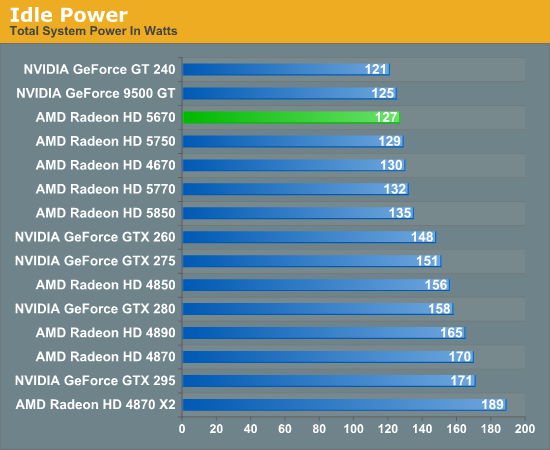
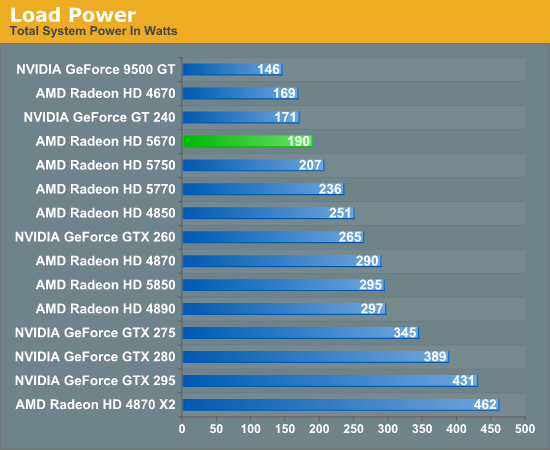
The one thing AMD can’t quite best the GT 240 at is idle power. Here the GT 240’s sub-10W idle means the 5670 idles slightly higher. With that said it’s the 3rd lowest card of all time, behind only the GT 240, and the significantly slower 9500 GT.
Load power paints a different picture however, and this is where the concept of a “power virus” pokes its head up again. The 5670 has a lower TDP than the GT 240 according to the specs published by AMD and NVIDIA - at 61W and 70W respectively - and we have no reason to doubt these numbers. But here the load power of the 5670 is much higher, by just shy of 20W. You’ll notice here that the 4670 is also much lower in spite of similar specs – all of this leads us to believe that the other cards are throttling themselves some as compared to the 5670, whose VRM protection features let it run away compared to these cards. Compared to the 5750 the data is correct, so that makes a better reference point than the GT 240 or 4670.
Accounting for these quirks, the 5670 should be between the 3rd and 2nd lowest power consuming card that we have on-hand.
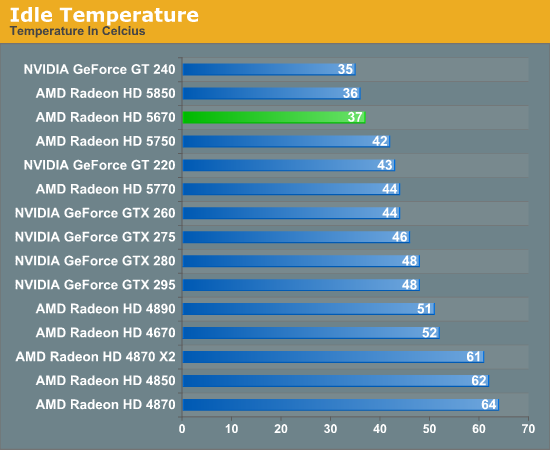
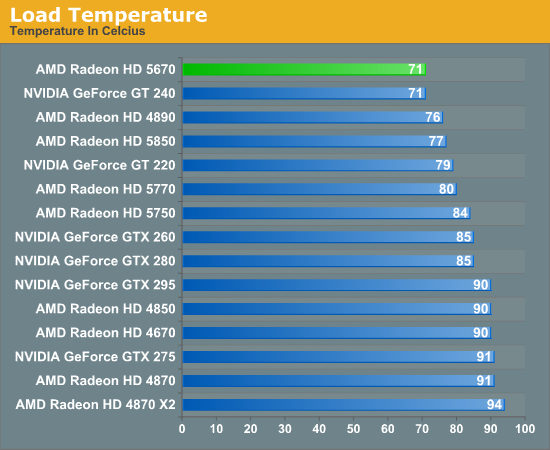
Less power usage leads to less heat, and in this case this means the 5670 once again trails the GT 240, which benefits from said lower power usage and the dual-slot cooler on our specific card. It’s still the 3rd best card however, beating everything except said GT 240 and the remarkably cool 5850.
At load, the picture looks very good for AMD. Even though we’re using a dual-slot cooler, thanks to the low load power usage we’re looking at a tie for the lowest load temperatures we’ve ever recorded. The dual-slot GT 240 ties at 71C, and we’re several degrees from anything else. The results are particularly good compared to the 4670, which was an inferno at 20C higher in this test.
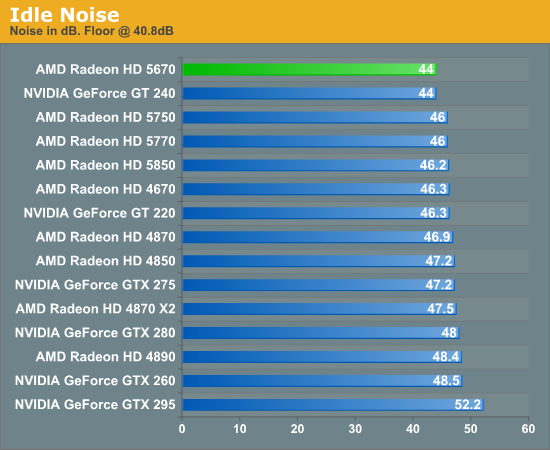
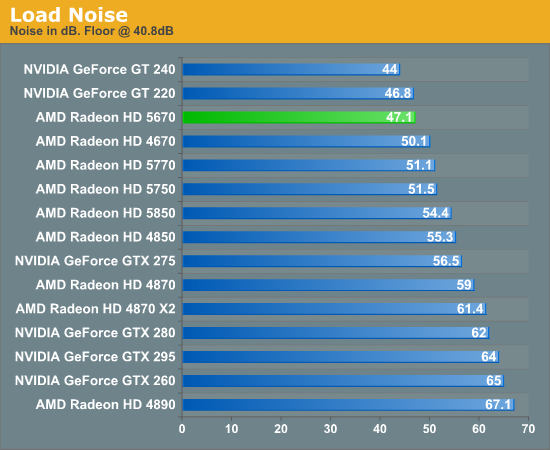
Finally there’s noise. As is the case with all of our other cards, the noise at idle is virtually indistinguishable from the noise generated by the rest of the computer.
At load the 5670 continues to be a quiet card, at only 3dB louder than idle. The only thing it falls behind here are the GT 220 and GT 240, both of which use dual-slot coolers and can afford the use of a larger, quieter fan. This is actually very impressive for a single-slot blower.
All of this data points to the 5670 making for a good HTPC card, certainly one as good if not better than the GT 200 series, and definitely better than the 4670. It’s cool and quiet, everything an HTPC card needs. However we’re more interested in where the 5500 series would place here – few HTPCs need this much rendering power, and with the 5500 series sub-50W power draw, it may be an even better choice.










73 Comments
View All Comments
krumme - Thursday, January 14, 2010 - link
KO 1 roundShadowmaster625 - Thursday, January 14, 2010 - link
Where is the 4770 and 9800GT??? A lot of the the data makes me skeptical because it doesnt mesh with what I'm seeing on other sites. I'm more inclined to trust the other reviews because they used common sense and compared this card to more cards in its own price range. Common sense is your friend. Notice how close the 5670 and 5750 are in terms of load power. That dont make sense at all.Ryan Smith - Thursday, January 14, 2010 - link
The 9800 GT is the same as an 8800 GT. As for the 4770 it's here too, although I don't have any 19x12 data for it since that resolution was a last-minute decision (I only had 30 hours or so with the 5670).ereavis - Thursday, January 14, 2010 - link
Common sense dictates that if a 4770 performs like a 4850 clone in most cases, leave it out for saturation purposes. Same case for the 9800GT, GTS 250 is a rebranded 9800GT, near identical performance.Price point? 9800GT and 4770 are next-to-unavailable, so what price should be used on something that can't be bought (in the near future when 5670 is all that's left on ATI side and GT 250 for nVidia but this review is still sitting on this site).
How can a power meters measured numbers "not make sense"? A much better performing 5750 at near 5670 power usage just means inefficiency at 5670 performance, which is common for lower performance parts on similar fab.
Explanation of the above would be a bonus, but hardly required, great review.
daytrader7 - Thursday, January 14, 2010 - link
4850's for 99 bucks a pair?Methinks not.
silverblue - Thursday, January 14, 2010 - link
No I think he meant that he'd seen a couple of instances where a 4850 was priced as low as $99, not that it costs $99 to have two of them.If it only cost that, hell I'd import two myself.
daytrader7 - Thursday, January 14, 2010 - link
Ahh...2 different 4850's available @ 99.00 each.
Misinterpretation on my part.
Zool - Thursday, January 14, 2010 - link
Also want to note that without real nvidia cards for amd it seems enough just to beat the weak nvidia setup and thats all.Eyfinity is just plain stupid on these level of cards for games. Real DX11 games on these performance levels is questionable at least too.
Both 5700 and 5600 are VERY weak for the price they sell. I wouldnt recomend them to anyone if they own a 4800 or 4600 series card, just in case they need a new card in a new machine.
The feature set with new generation of cards, including audio bitstreaming should be a MUST and not a priced upgrade put in the cards cost. Iam quite dissapointed form the amd-s 5600 and 5700 series cards. The only real new cards are the radeon 5800-s.
MadMan007 - Thursday, January 14, 2010 - link
I agree with Zool. The 5800s are the only true advancement among this 5000 series. They actually improved performance and price/performance (well, until pricing got out of hand because of supply) over their equivalent lineup predecessors and against their competition from NV. The 5700s and apparently 5600s are just spinning wheels performance-wise: they are feature upgrades not performance upgrades. That makes them mildly disappointing and not an easy purchase decision.marc1000 - Friday, January 15, 2010 - link
I had a 3850. Buying a 5770 was a fairly easy decision to me. I wanted the 5850 in fact, but to buy this one I would need to change my PSU too and that would be too expensive. So the 5770 it was! And I'm pretty glad with the performance. Remember that not everyone has the latest board from previus generation. ATI/AMD is doing a great job.